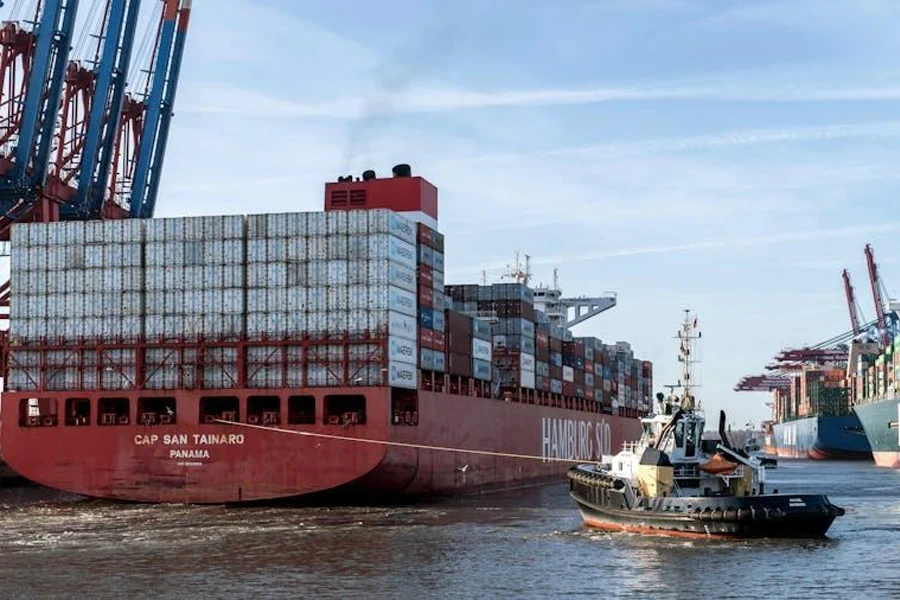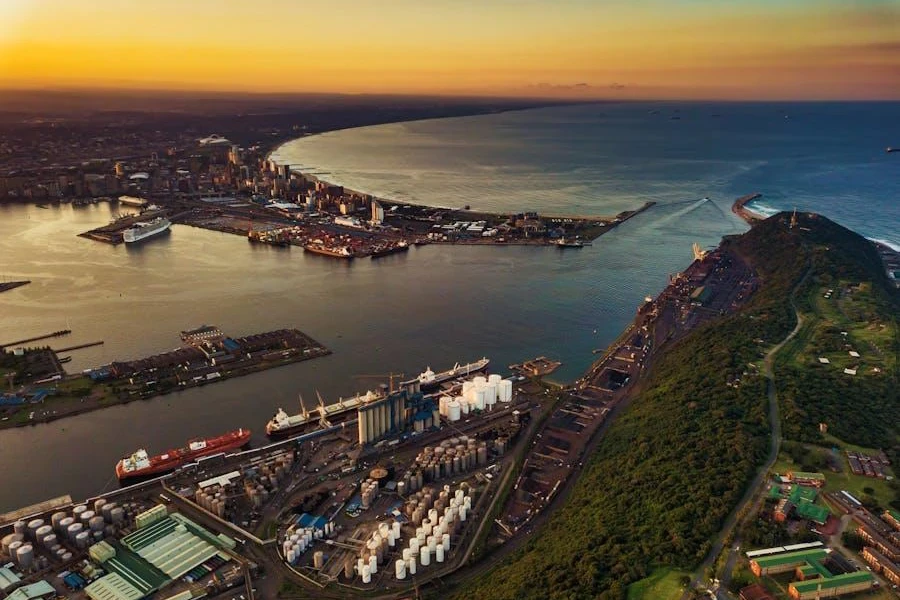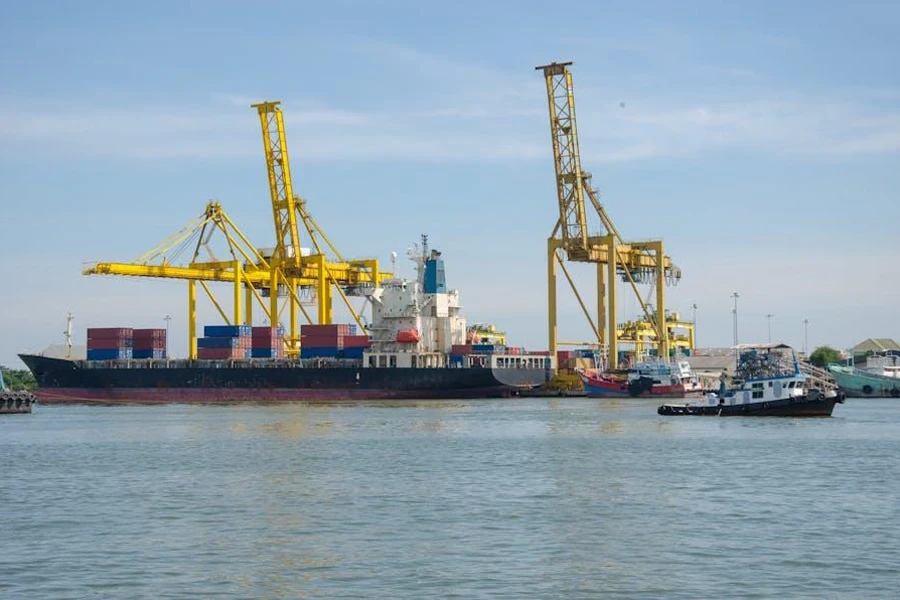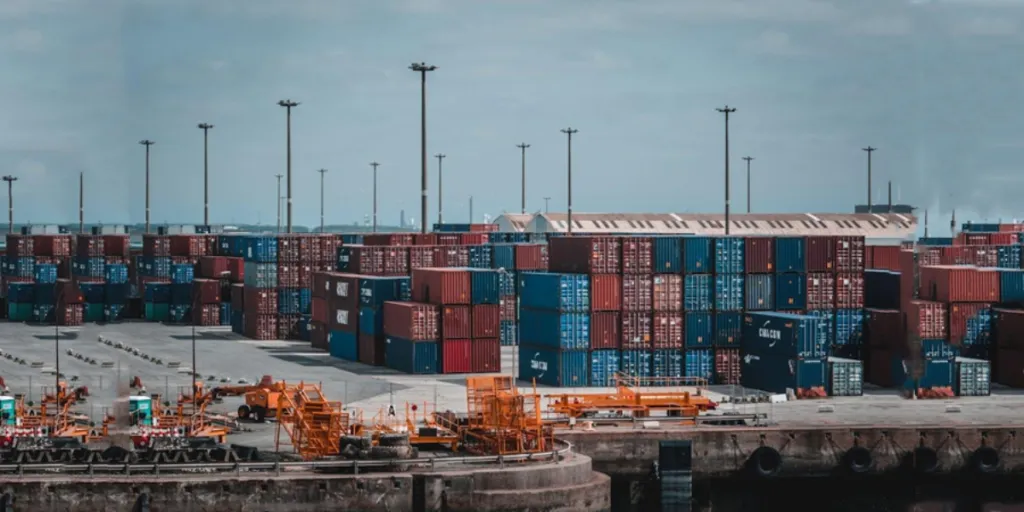Major ports are big hubs located on the coast where ships come and go, carrying lots of different goods from one place to another. They handle all sorts of items, including toys, clothes, electronics, food, and fuel.
These ports have special areas for unloading and storing containers, cranes to lift heavy stuff, and sometimes even warehouses to keep things cold, like fruits and veggies. They also have deep water so that very large ships can come in.
From the sprawling complexes in Texas to the dynamic waters of New York and the innovative harbors of California, the major US ports serve as gateways connecting the United States to distant shores around the globe. In this blog, we’ll take a closer look at the top five major US ports (ranked by their total tonnage):
- Houston Port Authority, Texas
- South Louisiana Port, Louisiana.
- Corpus Christi Port, Texas
- New York Port, NY & NJ
- Long Beach Port, California
Continue reading to explore the impressive facilities and key features that help these major ports handle masses of cargo day in and day out!
Table of Contents
1. Houston Port Authority, Texas
2. South Louisiana Port, Louisiana
3. Corpus Christi Port, Texas
4. New York Port, NY & NJ
5. Long Beach Port, California
6. Major US ports are trade gateways to global markets
1. Houston Port Authority, Texas

Description
Known simply as the Port of Houston, this remarkable port is a testament to the region’s historical and economic development. Established over a century ago, it has grown to become one of the busiest ports in the United States, playing a pivotal role in international trade and the local economy.
The Port of Houston was officially opened to deepwater traffic in 1914 following successful dredging efforts to create the Houston Ship Channel. This development strategically connected the busy port with the Gulf of Mexico, laying the foundation for its future as a linchpin in US maritime trade.
Features and key facilities
Spanning 52 miles inland from the Gulf of Mexico, the Houston Ship Channel has nearly 200 public and private terminals. These facilities showcase the vast scope and capability of the port, supporting a wide range of maritime operations.
Connectivity is a key feature of the Port of Houston. It is well-connected to several major roads, including National Highway System routes I-10, I-45, U.S. Route 69, I-610, and US-90, facilitating smooth land transport.
Additionally, it boasts direct links to major rail networks managed by the Union Pacific Railroad and the Port Terminal Railroad Association, ensuring efficient distribution and collection of goods.
In terms of facilities, the Port of Houston includes eight public terminals and over 100 private terminals. These handle various cargo types, from bulk and break bulk to project and roll-on/roll-off cargoes.
The port recently augmented its capabilities with three new 158-foot-tall ship-to-shore cranes. These new additions increase loading and unloading efficiency and are fully electric, aligning with contemporary standards for environmental responsibility.
Cargo throughput and top commodities
In 2023, the Port of Houston reached a monumental cargo throughput of 50,323,264 tons, underlining its essential role in global and domestic markets. Reflecting the diversity of its operations, the port handles a wide assortment of commodities. The leading categories are:
- Crude petroleum: Comprising 17% of total cargo;
- Distillate fuel oil: Accounting for 12%;
- Hydrocarbon and petrol gases: 11% of the throughput;
- Gasoline: Representing 9%;
- Naphtha and solvents: Encompassing 5%;
- All others: Making up 45% of the throughput, with wheat being the standout food product.
2. South Louisiana Port, Louisiana

Description
The Port of South Louisiana is a pivotal nexus for maritime commerce not just in the United States but also for international markets. Situated strategically between Baton Rouge and New Orleans, the port’s rich history is woven into the very fabric of the region, with roots tracing back to the era when trade along the Mississippi flourished with the steamboat era.
Today, the Port of South Louisiana is emblematic of the region’s enduring economic vitality and commitment to growth. It stands proudly as a beacon of trade in Louisiana, seamlessly connecting the heartland of America to the rest of the world.
Features and key facilities
The Port of South Louisiana stretches 54 miles along the Mississippi River. Blessed with prime access to significant transportation routes, it connects seamlessly to National Highway System routes I-10, I-55, I-310, US-61, and US-90, as well as to major railways like the Canadian National Railway and Kansas City Southern Railway Company.
Continually investing in its infrastructure, the port is now enhancing its capabilities by constructing a second dock access bridge at PortSL’s Globalplex. The public Globalplex Intermodal Terminal accommodates dry bulk—such as cement, woodchips, and mineral ores—as well as break bulk and containerized cargo, showcasing the port’s adaptability to various trade needs.
Cargo throughput and top commodities
The numbers speak for themselves in granting the Port of South Louisiana the title of preeminent grain exporter in the United States and the second-largest tonnage port in the Western Hemisphere. In 2023, the port handled a staggering 248,130,992 short tons of cargo, indicative of its massive scale and efficiency.
The port’s top commodities reflect its diverse functionality and strategic position in the global supply chain. Here are the standout cargo types:
- Corn: At 25%, highlighting the port’s significant role in agribusiness;
- Soybeans: Representing 16%, underscoring the port’s status as a grain-export powerhouse;
- Distillate fuel oil: Making up 10% of the port’s cargo;
- Crude petroleum: Accounting for 5%, demonstrating the port’s importance to the energy sector;
- Gasoline: Amounting to 4%, facilitating the distribution of this essential fuel;
- All others: Comprising 40% of throughput, showcasing the diverse functionality of the port.
3. Corpus Christi Port, Texas

Description
Nestled on the shores of Corpus Christi Bay, the Port of Corpus Christi serves as a vibrant and critical nexus for maritime activities in the Gulf of Mexico, south of San Antonio, Texas. This hub of trade and transport dates back to its inception, continuously expanding and evolving to accommodate the growing demands of both inland and oceangoing ventures.
Renowned for its strategic positioning, the port ensures a seamless transfer of goods between the sprawling inland waterways and the vast expanse of the Gulf, bridging local markets with global routes.
Features and key facilities
The Port of Corpus Christi is strategically located with direct access to significant transportation corridors such as I-37 and US-181 and is serviced by major railroads, including the Kansas City Southern Railway Company and the Union Pacific Railroad. These connections facilitate the rapid transport of goods to and from the port.
Moreover, the port boasts specialized terminals on both its north and south sides, equipped to manage break bulk, roll-on/roll-off (Ro/Ro), heavy-lift, and project cargoes. Furthermore, the port’s capacity to handle energy commodities is exemplified by its multiple public petroleum docks, which specialize in transferring crude oil and petroleum products by both ship and barge.
The ongoing Corpus Ship Channel Improvement Project (CIP) is a significant development enhancing the port’s operational capabilities, poised for completion by early 2025. This ambitious project aims to deepen and widen the ship channel, thereby accommodating larger vessels and increasing the port’s cargo handling capacity.
Cargo throughput and top commodities
In 2023, the Port of Corpus Christi witnessed an unprecedented movement of approximately 200 million tons of cargo through its channel, largely propelled by crude oil exports. This volume is a testament to the port’s robust infrastructure and its pivotal role in facilitating energy trade.
The composition of cargoes highlights the port’s specialization and strategic relevance in the energy sector, with the following being the top commodities:
- Crude petroleum: Dominating the cargo mix with 62%, reflecting the port’s key role in the energy export market;
- Hydrocarbon and petrol gases: Accounting for 10%, underscoring the port’s significant contribution to the global gas trade;
- Distillate fuel oil: Making up 5%, another crucial energy product facilitated by the port;
- Gasoline: Comprising 4%, essential for meeting both domestic and international fuel demand;
- Naphtha and solvents: Totaling 3%, indicating the port’s involvement in the chemical and petrochemical sectors;
- All others: Comprising 16%, indicating a diverse range of other goods and commodities handled.
4. New York Port, NY & NJ

Description
Spanning the mouth of the Hudson River and embracing both Upper New York Bay and Newark Bay, the Port of New York and New Jersey serves as a monumental gateway for maritime trade.
From its humble beginnings as a fledgling trading post to becoming one of the world’s largest and most vital ports, its history is fascinating. It has witnessed the evolution of maritime commerce and the rise of global trade networks, and it has played a central role in shaping the economic landscape of New York and New Jersey and the entire United States.
Features and key facilities
The Port of New York and New Jersey is seamlessly integrated into the broader transportation network, boasting close connections to key National Highway System routes, including I-78, I-278, and I-478, alongside major railroads such as CSX Transportation and New York New Jersey Rail.
The port features six public container terminals, which collectively form the backbone of the port’s operations. These terminals are adept at handling many cargo types, including Ro/Ro (roll-on/roll-off), project, and break-bulk cargo.
Additionally, the 25th Street Pier stands out as a specialized public dry bulk terminal. Currently leased to a private operator, this facility is crucial for the handling of construction materials like cement, sand, and stone, which are fundamental to the region’s construction industry.
A key development in 2023 has been the launch of the Port Street Corridor Improvement project. Aiming to redesign the port’s northern entrance via road, this project promises to enhance logistical efficiency significantly.
The project is expected to facilitate smoother traffic flow, reduce congestion, and improve the port’s northern gateway’s overall safety and operational capacity by introducing a more efficient roadway configuration and a wider turning radius.
Cargo throughput and top commodities
In 2023, the Port of New York and New Jersey reached a significant milestone by handling an impressive 7.8 million TEUs (twenty-foot equivalent units), affirming its position as the nation’s second busiest port for loaded imports and exports.
The port’s top commodities paint a vivid picture of its diversified cargo base:
- Gasoline: The lifeline of transportation accounts for 17%;
- Distillate fuel oil: Distillate fuel oil, vital for heating and powering machinery, comprises 12% of the cargo.
- Crude petroleum: The raw backbone of countless products adds up to 9%;
- Residual fuel oil: Indispensable for ships and power plants, residual fuel oil represents 7%;
- Manufactured products, NEC: With 5%, manufactured products cover a gamut of goods not categorized elsewhere;
- All others: A whopping 50% of cargoes fall under the ‘All others’ category, a testament to the port’s versatility in handling a broad spectrum of goods.
5. Long Beach Port, California

Description
Located on the coast of Southern California, the Port of Long Beach serves as a vital gateway for US-Asia trade. Marking its place on the map of significant maritime routes, it lies on San Pedro Bay, closely knitted with its neighbor, the Port of Los Angeles.
The rich history of the Port of Long Beach stretches back over a century, evolving from a mere scattering of docks and piers in the early 1900s to one of the world’s busiest seaports. Its strategic location and continuous improvements have made it a focal point of international trade and commerce.
Features and key facilities
The Port of Long Beach boasts an interconnected network of transportation, linking it seamlessly to the world beyond through major highways such as I-110, and I-710 and various railroads, including the Pacific Harbor Line, BNSF Railway, Union Pacific Railroad, and Richmond Pacific Railroad.
This port is home to more than 20 terminals, each designed to handle various cargo types ranging from dry bulk to refrigerated goods and everything in between. These terminals are outfitted with cutting-edge technology to ensure cargo’s smooth handling and storage.
However, perhaps the most ambitious project under its belt is the construction of the Pier B On-Dock Rail Support Facility. This project aims to drastically enhance the port’s cargo handling capacity by doubling the size of the existing Pier B rail yard to 171 acres. Once completed, the facility is expected to bolster the port’s on-dock rail capacity, handling an impressive 4.7 million TEUs (twenty-foot equivalent units) annually.
Cargo throughput and top commodities
In the recent year of 2023, the Port of Long Beach achieved a remarkable feat, handling 8 million TEUs. This figure highlights the port’s position as a cornerstone in Transpacific trade. With a whopping USD 200 billion worth of trade flowing through annually, the port connects businesses and consumers across continents.
The diversity of cargo passing through the port is vast, highlighting its strategic importance to various industries. The primary commodities include:
- Crude petroleum (29%): Representing 29%, this underscores the port’s pivotal role in fueling businesses and homes;
- Manufactured products, NEC: Comprising 11%, this reflects the port’s versatility in handling specialized goods;
- Crude coke: Essential for various industrial processes, crude coke accounts for 5%, demonstrating the port’s strong linkage to industrial supply chains;
- Electrical machinery: Comprising 4%, ranging from household appliances to high-tech equipment, this category illustrates the port’s integral role in the electronics market;
- Distillate fuel oil: Representing 3% of cargo throughput, this further emphasizes the port’s critical position in the global energy supply chain;
- All others: Comprising 46% with a variety of products. Among these, animal feed tops the list, showcasing the port’s significance in the agricultural sector.
Major US ports are trade gateways to global markets
It’s clear that the major US ports of Houston, South Louisiana, Corpus Christi, New York, and Long Beach are more than just points on a map. They are powerful engines driving the U.S. economy, processing massive quantities of goods, and connecting markets across oceans and continents.
Understanding each port’s capabilities and specialties can provide a significant competitive edge for businesses. Whether it’s oil and petrochemicals in Houston and Corpus Christi, agricultural products in South Louisiana, or consumer goods flowing through New York and Long Beach, each port has its strengths and focal commodities.
Visit Alibaba.com Reads for more industry-led insights into global logistics and trade!

Looking for a logistics solution with competitive pricing, full visibility, and readily accessible customer support? Check out the Alibaba.com Logistics Marketplace today.




